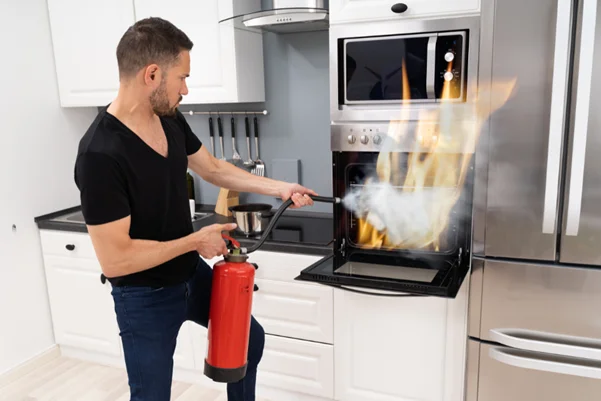
Grease fires are one of the most dangerous types of fires in the kitchen. Unlike other fires, grease fires can spread rapidly and are incredibly difficult to control. Whether you’re frying, sautéing, or cooking with oil, it’s crucial to know how to extinguish a grease fire if it arises safely. In this blog, we will provide valuable tips on how to put out a grease fire, what to do (and not do) in the event of one, and how to minimize fire damage with the help of a fire damage restoration service.
What is a Grease Fire?
A grease fire occurs when cooking oil or fat ignites too hot. The key risk factors are typically high heat and combustible oils. These fires can quickly escalate and spread, particularly when water is introduced, causing even greater danger. Understanding how to respond promptly and effectively can prevent the fire from causing severe damage to your kitchen and home.
How to Put Out a Grease Fire Safely and Effectively
When a grease fire starts, staying calm and acting fast is essential. The following steps are the safest and most effective ways to put out a grease fire:
Turn Off the Heat Source
When a grease fire starts, the first thing you should do is turn off the stove or heat source. Removing the heat will prevent the fire from continuing to burn or spreading further. However, if the fire is too large to control, do not attempt to handle it alone. Evacuate the area immediately and call 911.
Use a Lid or Cookie Sheet to Smother the Fire
One of the best ways to extinguish a grease fire is to cut off its oxygen supply. If the fire is small and contained in a pan or pot, cover it with a lid or cookie sheet. This will suffocate the flames and prevent them from growing. It’s essential not to use a glass lid because it can shatter under high heat, worsening the situation.
Use Baking Soda on a Grease Fire
If a lid isn’t available, you can use baking soda to put out a grease fire. Baking soda works by releasing carbon dioxide when it’s heated, which helps to smother the fire. To put out the fire, just liberally sprinkle the fire with baking soda. Avoid using flour, sugar, or salt, as these can make the fire worse.
Use a Fire Extinguisher
It’s essential to have a Class K fire extinguisher for larger grease fires. Class K extinguishers are made especially to put out kitchen fires that involve fats and oils. To use the fire extinguisher, remember to pull the pin, aim the nozzle at the base of the fire, and use a sweeping motion to release the extinguishing agent. Keep a safe distance, and do not attempt to fight the fire if it’s already out of control.
Stay Calm and Avoid Water
One of the most dangerous mistakes people make during a grease fire is trying to extinguish it with water. Water can cause the oil to splatter, spreading the fire and making it much worse. If you ever encounter a grease fire, never use water. Always follow the methods mentioned above to smother or suppress the fire safely.
How Do You Put Out an Oil Fire?
Oil fires, much like grease fires, should be handled with care. The process for extinguishing an oil fire is essentially the same as a grease fire. You can use a lid, baking soda, or a fire extinguisher, but the key takeaway is to never use water. If you’re unsure of how to control the fire, evacuate the area and call for professional help immediately. Fire damage restoration can help you clean up any damage caused by the fire and restore your home to its original condition.
What is the Best Way to Put Out a Grease Fire?
The best way to put out a grease fire depends on the size of the fire and the tools available to you. The key methods include:
- Smothering the fire with a lid: This is ideal for small fires and can be done quickly to prevent the fire from spreading.
- Using baking soda: For small to medium-sized fires, baking soda works well and is a cheap and safe approach to put out the flames.
- Using a fire extinguisher: For larger grease fires, a Class K fire extinguisher is the most effective tool for putting out the fire safely.
- Evacuating the area: If the fire is out of control or you’re unsure how to manage it, evacuating your home and calling 911 is the safest option.
How to Put Out a Kitchen Grease Fire
A kitchen grease fire can occur when you’re cooking with high heat and oils. These fires are particularly dangerous because they can spread rapidly and cause significant damage to your kitchen. The key to putting out a kitchen grease fire is acting quickly and using the proper tools. As mentioned, always keep a lid, baking soda, and a Class K fire extinguisher in your kitchen to ensure you’re prepared for emergencies.
If the fire continues to grow, evacuate your home immediately. Never try to put out a large fire on your own, as this can put you in grave danger.
Can You Use Water on a Grease Fire?
No! Water should never be used on a grease fire. When water contacts hot oil, it instantly turns to steam, causing the oil to splatter and spread the fire. This can cause the fire to grow uncontrollably, making the situation even more dangerous. Always avoid using water on grease fires and follow the proper methods outlined in this blog.
How to Prevent a Grease Fire in the Future
Even while mishaps sometimes happen, there are a few things you can do to stop grease fires before they start:
- Monitor your cooking: Never leave a pan of hot oil unattended. Stay in the kitchen and keep a close eye on the heat.
- Keep flammable items away from the stove: Keep towels, paper towels, and other flammable materials far from the cooking area.
- Maintain your equipment: Ensure your stove, oven, and cookware work well. Old or damaged equipment can lead to fires.
Why Ask Professionals for Help
If a grease fire gets out of control and damages your kitchen or home, it’s important to contact a fire damage restoration service as soon as possible. A professional restoration company will help you restore your property, clean up any damage, and ensure the affected areas are safe to use.
These services typically involve:
- Assessing the damage: A trained technician will assess the damage caused by the fire and determine the best course of action.
- Cleaning up the debris: The restoration company will remove soot, smoke residue, and damaged materials.
- Restoring your home: Restoration services include repairing structural damage, repainting walls, and replacing appliances or furniture damaged by the fire.
If you need professional assistance handling fire damage, you can call us for expert help.
Although grease fires pose a significant risk in the kitchen, they may be managed safely and successfully if you have the right information. Remember to stay calm, avoid using water, and use tools like lids, baking soda, or a fire extinguisher to extinguish the flames. Don’t hesitate to evacuate and call emergency services if a fire gets out of hand. After the fire is extinguished, you must contact a restoration company to ensure your property is restored correctly.
Following these safety tips and knowing how to put out a grease fire can protect your kitchen and keep your home safe from potential fire damage.
